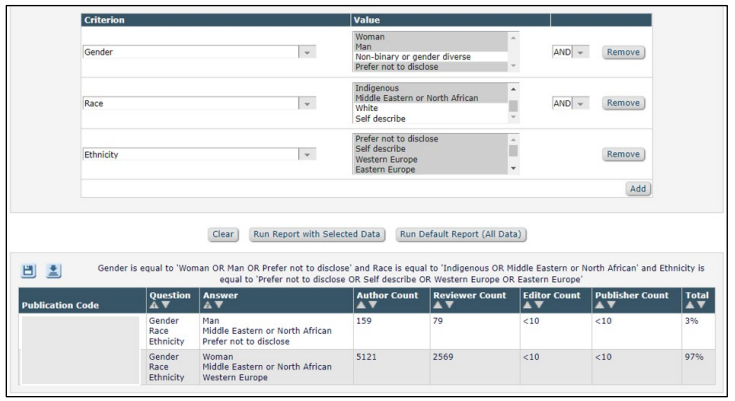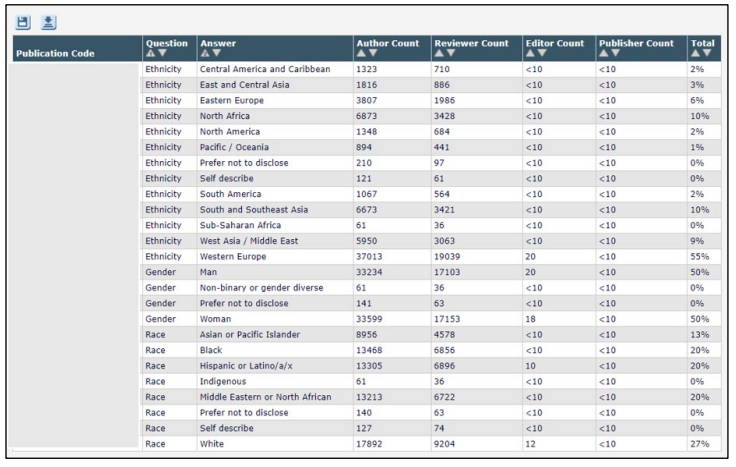Inclusionary data reporting
Release notes
See also Release notification.
Inclusionary Data Collection Reporting. User role impact: EDITOR
The purpose of inclusionary data collection is to gather demographic information on individuals involved in scholarly research and publishing. The Joint Commitment for action on inclusion and diversity in publishing, a collective of publishers led by the Royal Society of Chemistry, has developed a standardized approach to collecting self-reported gender identity, race, and ethnicity data.
The Inclusionary Data Collection feature provides a standard three-question diversity, equity, and inclusion (DEI) survey that publishers can use to gather data when users log in to their Editorial Manager sites. Each publisher owns its own data, which are stored in a cloud database hosted by Aries.
This enhancement enables Editors with permission to run reports on the anonymized DEI data from within EM. A new Inclusionary Data Collection Report tool allows Editors to define and save reports, view results onscreen, and download report results. A link to the new report tool appears in the Report Tools section of the Reports page.
The Inclusionary Data Collection Report page enables users to define a report by selecting criteria and running the report, to use a previously saved report definition, or to run the default report to view an aggregated report of all data from their publication. Once report definitions are saved, they can be rerun,
shared (made available to other users), edited, or removed.
The report tool is similar to other search tools in EM. The user selects a search criterion from the drop-down menu and chooses values from a multi-selector list. Additional criteria can be added. Then the user clicks Run Report with Selected Data to view the results.
- Values within each multi-selector are combined using “OR.” For example, if the user selects the
values “Indigenous” and “Middle Eastern or North African” for the Ethnicity criterion, the counts
returned will be for users who chose either “Indigenous” OR “Middle Eastern or North African” OR
both values; the results are not limited to users who chose both “Indigenous” AND “Middle Eastern
or North African.” - Each row (criterion/value(s) pair) can be combined using the AND/OR drop-down selector.
After a report is run, results are displayed below the tool. Defined filters used for the report appear above the results table. Counts for any category are shown as “<10” when the total is fewer than 10 individuals. Two icons appear at the top left of the results table. The Save icon can be used to save the defined report;
saved reports are added to the Report Definition drop-down menu. The Download icon can be used to download a tab-delimited file to the user’s computer.
Detail of Inclusionary Data Collection page: Criterion and value selectors shown at top; results shown at bottom, including details of the defined filters (shown above the results table).
Default report (all data) sample results: When the count for any category is fewer than 10 individuals,
the value is indicated as “< 10” and the exact number is not shown.
TO CONFIGURE:
The standardized version of the Inclusionary Data Collection feature must be enabled and configured for the publication. For more information and to enable the feature, contact your Aries Account Coordinator.
Go to RoleManager > Editor Roles and select the applicable roles. The new permission appears in the Administrative and Reporting Functions section as a sub-permission of Produce Reports. Both permissions must be enabled.
- Run Inclusionary Data Collection Reports: Check this box to allow access to the Inclusionary Data Collection Report page from the Reports menu.
PERMISSIONS:
On CEMD, the only role that can run these reports is: Aries Support.

